Wangshi Group
The Wangshi Group (Chinese: 王氏群; pinyin: Wángshì Qún) is a geological Group in Shandong, China whose strata date back to the Coniacian to Campanian stages of the Late Cretaceous.[1] Dinosaur remains are among the fossils that have been recovered from the group.[2]
| Wangshi Group | |
|---|---|
| Stratigraphic range: Coniacian-Campanian ~ | |
 An outcrop of the Wangshi Group at Kugou which is the type locality for Anomalipes zhaoi. Photographed in c. 2018. | |
| Type | Group |
| Unit of | Jiaolai Basin |
| Sub-units | Linjiazhuang, Jiangjunding, Xingezhuang, Hongtuya, Jingangkou & Shijiatun Formations |
| Underlies | Jiaozhou Formation |
| Overlies | Qingshan Group |
| Lithology | |
| Primary | Conglomerate |
| Other | Marl |
| Location | |
| Coordinates | 36.9°N 120.7°E |
| Approximate paleocoordinates | 37.3°N 111.0°E |
| Region | Shandong |
| Country | |
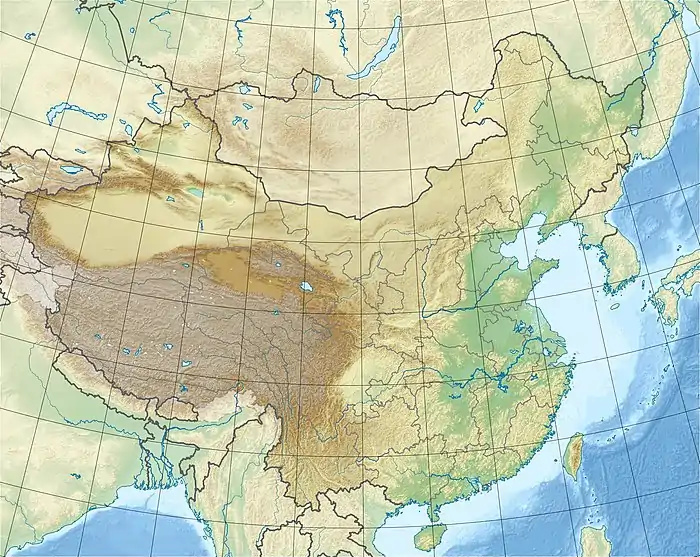 Wangshi Group (China) 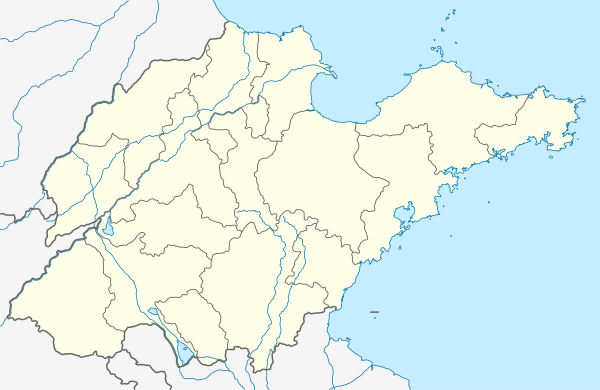 Wangshi Group (Shandong) | |
Vertebrate paleofauna
Dinosaurs
| Dinosaurs of the Wangshi Group | ||||||
|---|---|---|---|---|---|---|
| Genus | Species | Location | Stratigraphic position | Material | Notes | Images |
| Anomalipes[3] | A. zhaoi | "Partial left hindlimb" | A caenagnathid oviraptorosaur | |||
| Chingkankousaurus[4] | C. fragilis[4] | Nomen dubium | ||||
| Ischioceratops[5] | I. zhuchengensis |  | ||||
| Laiyangosaurus[6] | L. youngi | Jingangkou Formation | A saurolophine hadrosaur | 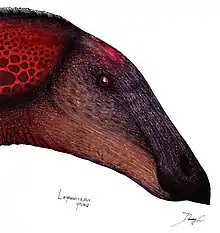 | ||
| Micropachycephalosaurus[4] | M. hongtuyanensis[4] | "Partial mandible, associated postcranial fragments."[7] |  | |||
| Pinacosaurus[8] | P. grangeri[8] |  | ||||
| Shantungosaurus[4] | S. giganteus[4] | Xingezhuang Formation | 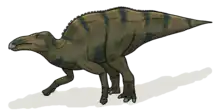 | |||
| Sinoceratops | S. zhuchengensis | Xingezhuang Formation | 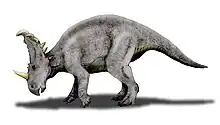 | |||
| Tanius[4] | T. chingkankouensis[4] | Jingangkou Formation | 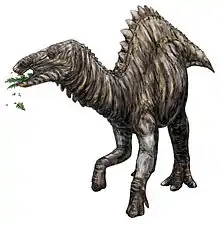 | |||
| T. laiyangensis[4] | Jingangkou Formation | Nomen dubium | ||||
| T. sinensis[4] | Jingangkou Formation | |||||
| Tsintaosaurus[4] | T. spinorhinus[4] | Jingangkou Formation | "Isolated skull and postcranial elements from at least [five] individuals."[9] | 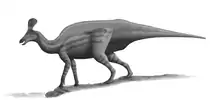 | ||
| Tyrannosaurus | "T." zhuchangensis[10] | Nomen dubium | ||||
| Zhuchengtyrannus[11] | Z. magnus[11] | Xingezhuang Formation |  | |||
| Zhuchengceratops | Z. inexpectus | Xingezhuang Formation |  | |||
| Zhuchengtitan[12] | Z. zangjiazhuangensis | Xingezhuang Formation | "a single humerus" | A titanosaur closely related to Opisthocoelicaudia | ||
Other fauna
| Other fauna of the Wangshi Group | ||||||
|---|---|---|---|---|---|---|
| Genus | Species | Location | Stratigraphic position | Material | Notes | Images |
| Shandongemys[13] | S. dongwuica | A lindholmemydid turtle | ||||
Fossil eggs
The following fossil eggs were recovered from the Jingangkou Formation of the Wangshi Group.[14][15]
- Saurischia
- Neornithischia
- Ovaloolithidae
- Ovaloolithus chinkangkouensis
- Ovaloolithus laminadermus
- Ovaloolithidae
Color key
|
Notes Uncertain or tentative taxa are in small text; |
References
- Wangshi Group in the Paleobiology Database
- Weishampel et al., 2004, pp.593-600
- Yilun Yu; Kebai Wang; Shuqing Chen; Corwin Sullivan; Shuo Wang; Peiye Wang; Xing Xu (2018). "A new caenagnathid dinosaur from the Upper Cretaceous Wangshi Group of Shandong, China, with comments on size variation among oviraptorosaurs". Scientific Reports. 8: Article number 5030. doi:10.1038/s41598-018-23252-2
- "48.9 Shandong, People's Republic of China; 1. Wangshi Group," in Weishampel, et al. (2004). Page 598.
- Yiming He, Peter J. Makovicky, Kebai Wang, Shuqing Chen, Corwin Sullivan, Fenglu Han, Xing XuMichael J. Ryan, David C. Evans, Philip J. Currie, Caleb M. Brown and Don Brinkman (2015). "A New Leptoceratopsid (Ornithischia, Ceratopsia) with a Unique Ischium from the Upper Cretaceous of Shandong Province, China".
- Zhang, J.L.; Wang, X.; Wang, Q.; Jiang, S.; Cheng, X.; Ning, L.; Qiu, R. (2017). "A new saurolophine hadrosaurid (Dinosauria: Ornithopoda) from the Upper Cretaceous of Shandong, China" (PDF). Annals of the Brazilian Academy of Sciences.
- "Table 21.1," in Weishampel, et al. (2004). Page 466.
- Listed as "Pinacosaurus cf. grangeri" in "48.9 Shandong, People's Republic of China; 1. Wangshi Group," in Weishampel, et al. (2004). Page 598.
- "Table 20.1," in Weishampel, et al. (2004). Page 442.
- Listed as Tyrannosaurus in Hu, Cheng, Pang and Fang (2001). but likely a different genus.
- David W. E. Hone; Kebai Wang; Corwin Sullivan; Xijin Zhao; Shuqing Chen; Dunjin Li; Shuan Ji; Qiang Ji; Xing Xu (2011). "A new, large tyrannosaurine theropod from the Upper Cretaceous of China". Cretaceous Research. 32 (4): 495–503. Bibcode:2011CrRes..32..495H. doi:10.1016/j.cretres.2011.03.005.
- Mo, J.; Wang, K.; Chen, S.; Wang, P.; Xu, X. (2017). "A new titanosaurian sauropod from the Late Cretaceous strata of Shandong Province". Geological Bulletin of China. 36 (9): 1501–1505.
- L. Li, H. Tong, K. Wang, S. Chen, and X. Xu. 2013. Lindholmemydid turtles (Cryptodira: Testudinoidea) from the Late Cretaceous of Shandong Province, China. Annales de Paléontologie 99:243-259
- Jingangkou in the Paleobiology Database
- Young, 1954
Bibliography
- Weishampel, David B.; Dodson, Peter; Osmólska, Halszka, eds. (2004). The Dinosauria, 2nd edition. Berkeley: University of California Press. ISBN 0-520-24209-2. Retrieved 2019-02-21.
- Hu, Cheng, Pang and Fang (2001). Shantungosaurus giganteus: [3 front matter] + ii + 139 pp. + 18 plates (in Chinese with English abstract; publisher's name not translated) ISBN 7-116-03472-2
- Young, C.-C (1954). "Fossil reptilian eggs from Laiyang, Shantung, China". Scientia Sinica. 3: 505–522.
This article is issued from Wikipedia. The text is licensed under Creative Commons - Attribution - Sharealike. Additional terms may apply for the media files.